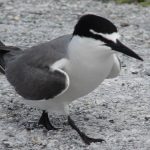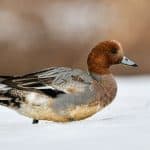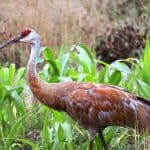Common Name: Ruff
Scientific Name: Calidris pugnax| Size | Diet | Range in Hawaii | Status in Hawaii |
|---|---|---|---|
| 9 in. - 11 in. | insects, worms, crustaceans, and other small invertebrates | Kaua'i, O'ahu, Moloka'i, Maui, and Big island | Least Concern |
The Ruff (Calidris pugnax) is a migratory bird species that is highly sociable and known for its unique appearance. This medium-sized wading bird breeds in marshes and wet meadows across northern Eurasia and forms large flocks during the winter months in various parts of the world, including southern and western Europe, Africa, southern Asia, and even Australia.
Interestingly, the Ruff has also been observed in Hawaii as a non-breeding visitor and occasional migrant, often found in wetlands and marshes. In this article, we will delve deeper into the fascinating world of the Ruff and explore the unique characteristics that make this bird species so intriguing.
Ruff
Appearance

The Ruff is a medium-sized shorebird with a distinct appearance. The adult males have a striking plumage variation, with a ruff of feathers around their neck that can be raised during courtship displays.
They measure about 9 to 11 inches in length, with a wingspan of approximately 18 to 20 inches. In contrast, the adult females and juveniles have a more subdued appearance, featuring a mottled brown and white plumage.
Overall, the Ruff exhibits sexual dimorphism, displaying a range of colors and patterns that make it a visually captivating species.
Diet
The Ruff has a diverse diet that primarily consists of insects, worms, crustaceans, and other small invertebrates. It forages in various habitats, including wetlands, mudflats, and grassy areas, using its long bill to probe the soil and water for prey.
During the breeding season, adult male Ruffs may also consume plant matter, such as seeds and leaves. This adaptable feeding behavior allows the Ruff to obtain the necessary nutrients for its survival and reproductive success.
Nesting
The Ruff is a wading bird that nests in the Arctic tundra and wetlands of northern Europe and Asia. During the breeding season, male Ruffs develop a distinctive ruff of feathers around their necks, which they use to attract females and compete with other males.
Ruffs typically nest on the ground, often in areas with low vegetation or near water. Females lay 3-4 eggs in a shallow scrape on the ground, which they incubate for about 22-24 days.
After hatching, the chicks are precocial and able to leave the nest within a few hours. The nesting season for Ruffs lasts from May to July, after which they migrate to their wintering grounds in Africa and southern Asia.
Behavior
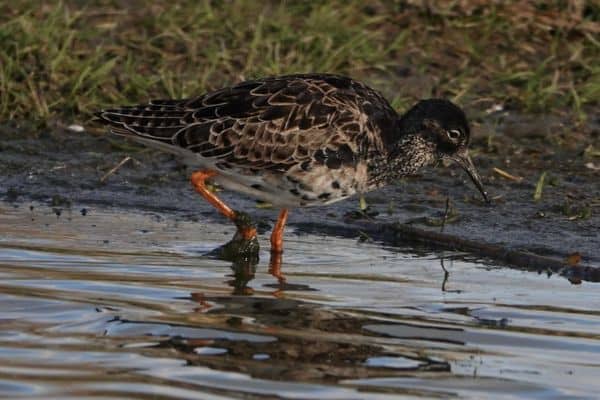
The Ruff displays fascinating behavior throughout its lifecycle. During the breeding season, male Ruffs undergo an impressive transformation, developing unique breeding plumage and elaborate display behaviors to attract females.
These displays often involve leaping, flapping their wings, and making distinct vocalizations. Male Ruffs form lekking aggregations, where they compete for the attention of females. The females, on the other hand, have more subdued plumage and select mates based on the displays and qualities of the males.
Outside of the breeding season, Ruffs exhibit migratory behavior, undertaking long-distance journeys between their breeding grounds in northern Europe, Asia, and North America, and their wintering areas in Africa, South Asia, and Australia. They navigate these impressive migrations, often covering thousands of miles, to take advantage of seasonal food resources and suitable habitats.
Ruffs are social birds and can be found in mixed flocks with other shorebirds during migration and wintering periods. They often forage together, probing the soil or water with their long bills to find food.
Ruffs are known for their territorial and aggressive behavior, especially during the breeding season when males fiercely defend their display territories against other males.
Habitat
The Ruff is a species of medium-sized wading bird that inhabits various wetland habitats throughout its range. This bird can be found in Europe, Asia, and parts of Africa.
These birds prefer to inhabit marshes, wet meadows, flooded fields, and coastal areas such as mudflats and estuaries. They are often seen near shallow water bodies, including freshwater ponds, lakes, and rivers, as well as brackish or saltwater environments.
Range
The Ruff has been observed in various locations across Hawaii, including the Northwestern Hawaiian Islands (Kure, Midway, Pearl and Hermes, Laysan, and French Frigate) and the Southeastern Hawaiian Islands (Kaua’i, O’ahu, Moloka’i, Maui, and Big island).
These sightings indicate the presence of the Ruff in both the remote and more populated regions of Hawaii, suggesting its ability to utilize diverse habitats during migration and possibly find suitable foraging areas along the coastal environments of the islands.
Conservation Status
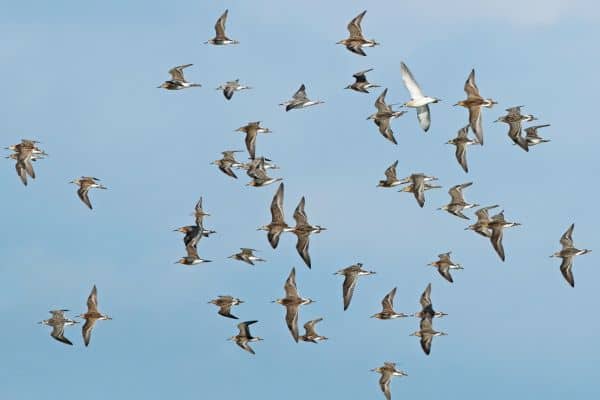
The Ruff is currently classified as “Least Concern” on the global IUCN Red List of Threatened Species. However, it is important to note that conservation statuses can change as new data and assessments become available.
The global Least Concern classification suggests that the overall population of Ruffs is relatively stable and not currently facing significant threats that would warrant a higher conservation status. However, regional assessments may provide a more nuanced perspective on the species’ conservation status in specific areas.
In Europe, the Ruff is assessed as “Near Threatened” on the regional Red List. This designation indicates that the species may be at risk of population declines or facing specific threats within the European region.
Interesting Facts
1. Lekking behavior
Ruffs engage in a unique courtship behavior called lekking. During the breeding season, males gather in groups and perform elaborate displays, including aerial acrobatics and fighting-like behaviors, to compete for the attention of females.
2. Dimorphic males
Male Ruffs display two distinct forms during the breeding season. The larger and more colorful “independent” males develop ornate plumage to attract females, while the smaller “satellite” males adopt a more subdued appearance and attempt to sneak copulations with females.
3. Migratory marvels
Ruffs undertake impressive long-distance migrations. They breed in the northern parts of Europe and Asia and travel to their wintering grounds in Africa, the Middle East, and southern Asia. Their migration routes can span thousands of kilometers.
4. Polygynous mating system
Male Ruffs engage in polygynous mating, meaning they mate with multiple females during the breeding season. The most successful males can mate with several females, while others may not find a mate at all.
5. Wetland specialists
Ruffs primarily inhabit wetland environments such as marshes, mudflats, and estuaries. They rely on these habitats for breeding, foraging, and resting, as they offer abundant food resources and suitable nesting sites.
Frequently Asked Questions
1. How do Ruffs attract mates?
Male Ruffs engage in lekking behavior, performing elaborate aerial and ground displays to attract females. The variation in their breeding plumage also plays a role in attracting mates.
2. Are Ruffs territorial?
Yes, male Ruffs can be territorial during the breeding season. They establish and defend territories where they perform their displays and attract mates.
3. How do Ruffs communicate?
Ruffs use a combination of vocalizations, displays, and body postures to communicate. Males have distinct calls during their displays, and vocalizations also play a role in establishing territories and maintaining social hierarchies.
4. How long do Ruffs live?
The average lifespan of a Ruff in the wild is estimated to be around 4 to 6 years. However, there have been recorded instances of individual Ruffs living up to 9 years or more.

